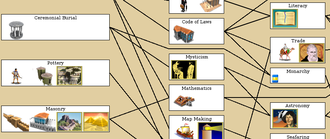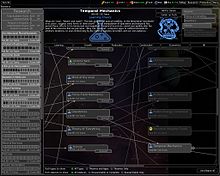
Sid Meier's Civilization is a 1991 turn-based strategy 4X video game developed and published by MicroProse. The game was originally developed for MS-DOS running on a PC, and has undergone numerous revisions for various platforms. The player is tasked with leading an entire human civilization over the course of several millennia by controlling various areas such as urban development, exploration, government, trade, research, and military. The player can control individual units and advance the exploration, conquest and settlement of the game's world. The player can also make such decisions as setting forms of government, tax rates and research priorities. The player's civilization is in competition with other computer-controlled civilizations, with which the player can enter diplomatic relationships that can either end in alliances or lead to war.

A strategy game or strategic game is a game in which the players' uncoerced, and often autonomous, decision-making skills have a high significance in determining the outcome. Almost all strategy games require internal decision tree-style thinking, and typically very high situational awareness.
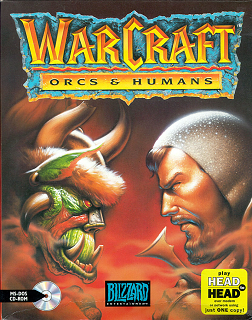
Warcraft: Orcs & Humans is a real-time strategy game (RTS) developed and published by Blizzard Entertainment, and published by Interplay Productions in Europe. It was released for MS-DOS in North America on 15 November 1994, and for Mac OS in early 1996. The MS-DOS version was re-released by Sold-Out Software in 2002.
Real-time strategy (RTS) is a subgenre of strategy video games that do not progress incrementally in turns, but allow all players to play simultaneously, in "real time". By contrast, in turn-based strategy (TBS) games, players take turns to play. The term "real-time strategy" was coined by Brett Sperry to market Dune II in the early 1990s.
A turn-based strategy (TBS) game is a strategy game where players take turns when playing. This is distinguished from real-time strategy (RTS), in which all players play simultaneously.

Master of Orion is a turn-based, 4X science fiction strategy game in which the player leads one of ten races to dominate the galaxy through a combination of diplomacy and conquest while developing technology, exploring and colonizing star systems.

4X is a subgenre of strategy-based computer and board games, and include both turn-based and real-time strategy titles. The gameplay involves building an empire. Emphasis is placed upon economic and technological development, as well as a range of military and non-military routes to supremacy.
Micromanagement in gaming is the handling of detailed gameplay elements by the player. It appears in a wide range of games and genres, including strategy video games, construction and management simulations, and pet-raising simulations. Micromanagement has been perceived in different ways by game designers and players for many years: some perceive it as a useful addition to games that adds options and technique to the gameplay, something that is necessary if the game is to support top-level competitions; some enjoy opportunities to use tactical skill in strategic games; others regard it as an unwelcome distraction from higher levels of strategic thinking and dislike having to do a lot of detailed work. Some developers attempt to minimize micromanagement in a game's interface for this reason.

Civilization IV is a 4X turn-based strategy computer game and the fourth installment of the Civilization series, and designed by Soren Johnson under the direction of Sid Meier and his video game development studio Firaxis Games. It was released in North America, Europe, and Australia, between October 25 and November 4, 2005, and followed by Civilization V.
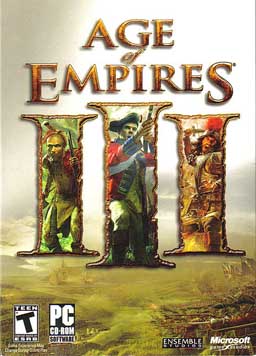
Age of Empires III is a real-time strategy video game developed by Microsoft Corporation's Ensemble Studios and published by Microsoft Game Studios. The Mac version was ported over and developed and published by Destineer's MacSoft. The PC version was released on October 18, 2005, in North America and November 4, 2005, in Europe, while the Mac version was released on November 21, 2006, in North America and September 29, 2006, in Europe. An N-Gage version of the game developed by Glu Mobile was released on April 28, 2009. It is the third game of the Age of Empires series and the sequel to Age of Empires II: The Age of Kings. A remaster titled Age of Empires III: Definitive Edition was released on October 15, 2020. Its successor, Age of Empires IV was released October 28, 2021, for Windows.

Master of Orion II: Battle at Antares is a 4X turn-based strategy game set in space, designed by Steve Barcia and Ken Burd, and developed by Simtex, who developed its predecessor Master of Orion and Master of Magic. The PC version was published by MicroProse in 1996, and the Macintosh version a year later by MacSoft, in partnership with MicroProse. The game has retained a large fan base, and is still played online.
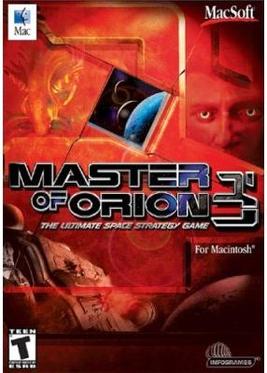
Master of Orion III is a 4X turn-based strategy game and the third in the Master of Orion series. Master of Orion III was developed by Quicksilver Software and published by Infogrames Interactive on February 25, 2003.

Sins of a Solar Empire is a 2008 science fiction real-time strategy video game developed by Ironclad Games and published by Stardock Entertainment for Microsoft Windows operating systems. It is a real-time strategy (RTS) game that incorporates some elements from 4X games; its makers describe it as "RT4X". Players are given control of a spacefaring empire in the distant future, and are tasked with conquering star systems using military, economic and diplomatic means.

Space Empires IV is a turn-based 4X strategy computer game developed by Malfador Machinations and published by Strategy First as part of the Space Empires series in which players control an alien race in an attempt at galactic conquest.

Fragile Allegiance is an open-ended 4X real-time strategy (RTS) game from Gremlin Interactive, released in 1996 for MS-DOS and Windows 95. The game begins on May 25, 2496, as the player begins their employment with TetraCorp who have set up a new asteroid mining franchise operation in the Fragmented Sectors. There are six alien races competing with Tetracorp for these resources. Beginning with one building and one million credits, the player is tasked with building up a successful mining operation to sell as much ore as possible to the Federation. Diplomacy is crucial to the success or failure of this franchise operation as the players' colonies begin to encroach on one another.
Strategy is a major video game genre that emphasizes thinking and planning over direct instant action in order to achieve victory. Although many types of video games can contain strategic elements, as a genre, strategy games are most commonly defined as those with a primary focus on high-level strategy, logistics and resource management. They are also usually divided into two main sub-categories: turn-based and real-time, but there are also many strategy cross/sub-genres that feature additional elements such as tactics, diplomacy, economics and exploration.

Age of Empires (AoE) is a real-time strategy video game based on history, developed by Ensemble Studios and published by Microsoft, and the first game in the Age of Empires series. The game uses the Genie Engine, a 2D sprite-based game engine. The game allows the user to act as the leader of an ancient civilization by advancing it through four ages, gaining access to new and improved units with each advance.
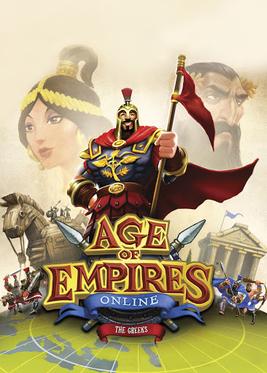
Age of Empires Online is a multiplayer online real-time strategy game developed by Robot Entertainment and Gas Powered Games, which released on August 16, 2011. Based upon the gameplay of the Age of Empires series, it was originally developed by Robot Entertainment, but on February 24, 2011, Gas Powered Games, took over production. The game was published by Microsoft.
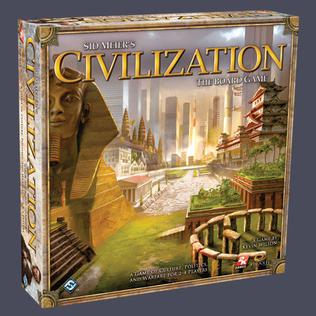
Sid Meier's Civilization: The Board Game is a 2010 board game created by Kevin Wilson based on the Sid Meier's Civilization series of video games and published by Fantasy Flight Games. While the previous board game based on Sid Meier's Civilization, published by Eagle Games in 2002, was based on Civilization III, the 2010 version takes its primary inspiration from Civilization IV. Its expansions, Fame and Fortune and Wisdom and Warfare, also began to incorporate concepts derived from Civilization V.
Endless Space is a 4X turn-based strategy video game, developed and published by Amplitude Studios, released on 4 July 2012, for Microsoft Windows and 31 August for Mac OS X. In the game, the player takes charge of fictional Space Age civilizations, expanding their influence by colonization and conquest. Endless Space sold over 1 million units, and earned the Unity Golden Cube award in 2013. The game's sequel, Endless Space 2, was released in 2017.
